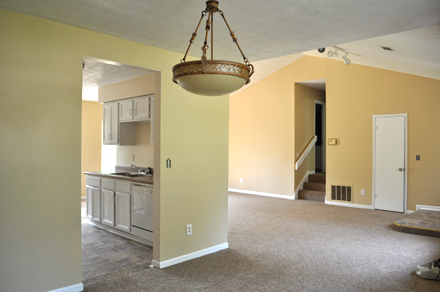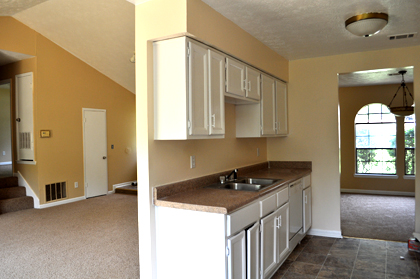 House #2 is officially rented!
House #2 is officially rented!
NOTE: This article was last updated in 2012 (and all numbers reflect that year).
Last week I showed the house to a man who liked it so much, he grabbed his checkbook and handed me a deposit on the spot.
I ran the necessary screening – credit check, criminal background – and he looks great.
He drives a brand-new Mercedes Benz, which costs twice as much as the house. 🙂
So how good of a deal was this?
The total cost – purchase plus repairs – came to $30,000, and the monthly rent is $895 per month.
The One Percent Rule says that a rental is a good deal if the gross monthly rent is 1 percent or more of the purchase price. In this case, the monthly gross rent is 2.98 percent of the purchase price. Score!!
But Does It Cash Flow?
Most new investors – myself included – start with the question, “Does this house have a positive cash flow?”
The problem with that question is that almost ANYTHING will positive cash flow if you buy in cash. You can’t decipher whether or not a house is a good investment based on that.
The better question is “What’s the house’s return on investment?” The common way to measure this is through a metric called the cap rate.
The cap rate shows you how long it will take you to recoup your costs. You figure this out by dividing the house’s price by the net cash flow.
In this case:
The Price: $30,000
Annual Gross Income = $10,740 ($895/mo * 12 months)
A quick glance at those numbers tells you that the gross income will pay off the cost of the house in less than 3 years. In other words, I’m getting a 35 percent gross return. That’s a good sign!
But I don’t care about “gross” return. I’m concerned about “net” income, which means income after expenses. So let’s look at the costs.
Yearly Costs:
Advertising = $150 per year (or per lease term)
Trash = $396 per year ($33/mo)
Insurance = $1,100 per year, approximate
Property Tax = $1,200/year, approximate
Management = $1,074 per year ($89.50/month, or 10 percent of gross rent).
Repairs and Maintenance = There are two competing rules of thumb here. One rule of thumb says that 50 percent of your rental income goes to maintenance/repairs/management.
I don’t think that rule applies here, for two reasons.
#1: Rent and maintenance are “independent variables” – one can move without impacting the other.
#2: I’ve heard from many investors that the 50 Percent Rule tends to apply to apartment buildings, not single-family homes. (Apartment buildings have higher operating expenses, as they need to maintain common areas like the lobby, hallways, parking lot, facilities, etc.)
A different rule of thumb says that 1 percent of your purchase price will be the home’s annual maintenance cost. I’m suspicious of this rule, as well, because the purchase price and the maintenance costs are also “independent variables.”
The purchase price fluctuates based on the economy, the neighborhood and the school district performance. The maintenance costs are based on how long your roof will last. These two are unrelated.
 But I’m willing to play ball. During the peak of the housing bubble, this house sold for $98,000.
But I’m willing to play ball. During the peak of the housing bubble, this house sold for $98,000.
Let’s take 1 percent of that, and assume the maintenance will cost $980 per year.
Yearly Costs = $4,900
Then add another 10 percent as a “safety margin” so that we have a conservative estimate.
Total Yearly Costs = $5,390
Now, subtract your Yearly Costs from your Gross Income, $10,740. This tells you the “net income,” which is your positive cash flow.
Cash Flow: $5,350 each year!! Wahoo!!
But wait! ANYTHING can have a positive cash flow if you buy it in cash. That doesn’t mean it’s a great investment.
So let’s take the final step and calculate the cap rate:
Cap Rate = Cash Flow / Price of House
Cap Rate = $5,350 / $30,000 = 0.178, which is a 17.8 percent return!! Happy dance!!
A 17.8 percent return is absolutely solid. At this rate, it will take me 5.6 years (100 / 17.8) to recoup the initial investment.
FAQ’s
Let me answer a few questions that I imagine this post is going to pose:
Q #1: Ouch. This sounds like a lot of math.
A: Technically, that’s not a question. But I get what you mean. As I said recently, I’m terrible at math.
Fortunately, this is all middle-school math. It ain’t calculus. And while it looks daunting, a few minutes of number-crunching can save you from a terrible investing decision (or push you into a great one!!)
Q #2: Wait a sec, I thought you did your own property management. Why are you subtracting the property management costs?
A: Yep, I do. But I need to make a profit AFTER paying myself. I can’t value my own time at $0, value someone else’s time at more than $0, and make a fair comparison between the two.
I pay a property manager. In this case, I hired myself to do that job. That’s not part of my return-on-investment, that’s a second job that I took on. (In other words, $5,350 is passive income; the additional $1,074 in my pocket is active income).
Q #3: Aren’t you forgetting the cost of yard work? And water bills?
A: The renter is expected to mow his own lawn and pay his own water bill! Whew! That’s because this is a single-family home, not a multi-unit building.
Q #4: I want to learn more about real estate investing. How can I do that?
Sign up for our free 7-day crash course on all things real estate investing:
UPDATE 2012: This post was updated on 10/18/2012 to reflect a less expensive property management fee — discovered after shopping around!
UPDATE 2015: I’ve started publishing monthly income reports. Check these out if you’re interested in seeing a more detailed snapshot of the entire rental property portfolio!